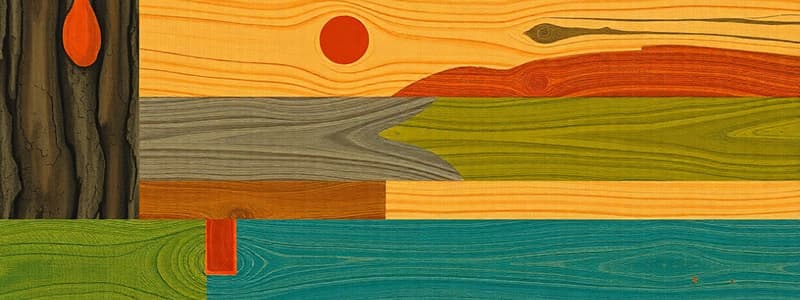Podcast
Questions and Answers
What is the term for a tree after its branches have been felled and separated?
What is the term for a tree after its branches have been felled and separated?
- seasoned timber
- softwood
- raw timber
- log (correct)
Which of the following trees is classified as endogenous?
Which of the following trees is classified as endogenous?
- coconut (correct)
- mahogany
- deodar
- teak
On what basis is timber classified in terms of availability?
On what basis is timber classified in terms of availability?
- I, II, III Class (correct)
- High, Medium, Low Quality
- One, Two, Three Grades
- Class A, B, C
Which classification describes trees that lose their leaves in the autumn?
Which classification describes trees that lose their leaves in the autumn?
What is the main purpose of seasoning timber?
What is the main purpose of seasoning timber?
Which part of an exogenous tree is the oldest?
Which part of an exogenous tree is the oldest?
How is the age of an exogenous tree typically assessed?
How is the age of an exogenous tree typically assessed?
Which of the following is NOT a softwood?
Which of the following is NOT a softwood?
Which of the following is a natural Pozzolanic material?
Which of the following is a natural Pozzolanic material?
Which one of the following is not a Pozzolanic material?
Which one of the following is not a Pozzolanic material?
What is the size of cubes used for testing compressive strength of cement?
What is the size of cubes used for testing compressive strength of cement?
Which proportion of cement to dry sand is recommended for masonry work?
Which proportion of cement to dry sand is recommended for masonry work?
An aggregate is referred to as fine aggregate if it passes through which sieve?
An aggregate is referred to as fine aggregate if it passes through which sieve?
The increase in volume of sand due to moisture is known as?
The increase in volume of sand due to moisture is known as?
What is the maximum increase in the bulk of sand at optimal moisture content?
What is the maximum increase in the bulk of sand at optimal moisture content?
Which of the following is not a desirable property of sand?
Which of the following is not a desirable property of sand?
What is the recommended value for impact testing of a wearing coat?
What is the recommended value for impact testing of a wearing coat?
Which type of timber grows outward and produces a distinct ring each year?
Which type of timber grows outward and produces a distinct ring each year?
What is the process of converting a log into commercial sizes like planks called?
What is the process of converting a log into commercial sizes like planks called?
What is a common building stone that does not contain calcium carbonate?
What is a common building stone that does not contain calcium carbonate?
Which test involves keeping a stone sample in hydrochloric acid to check for calcium carbonate?
Which test involves keeping a stone sample in hydrochloric acid to check for calcium carbonate?
What is the distinguishing feature of deciduous trees?
What is the distinguishing feature of deciduous trees?
What weight does the metal hammer in the impact testing machine typically have?
What weight does the metal hammer in the impact testing machine typically have?
What classification of timber is not characterized by cone-shaped trees?
What classification of timber is not characterized by cone-shaped trees?
What does bleeding of freshly laid concrete indicate?
What does bleeding of freshly laid concrete indicate?
What is the ratio of strength of concrete after 1 year to its strength at 28 days?
What is the ratio of strength of concrete after 1 year to its strength at 28 days?
What is evaluated by conducting a split test on cylindrical specimens?
What is evaluated by conducting a split test on cylindrical specimens?
Which one of the following is not a workability enhancing agent?
Which one of the following is not a workability enhancing agent?
Creep in concrete is primarily caused by which factor?
Creep in concrete is primarily caused by which factor?
The creep coefficient of concrete depends on which of the following factors?
The creep coefficient of concrete depends on which of the following factors?
Which of the following is not a lightweight concrete?
Which of the following is not a lightweight concrete?
What is the minimum cement content recommended for moderate exposure in concrete with normal weight aggregates?
What is the minimum cement content recommended for moderate exposure in concrete with normal weight aggregates?
What is added during the grinding process of cement?
What is added during the grinding process of cement?
Why should cement be stored off the ground?
Why should cement be stored off the ground?
Which type of cement is obtained by reducing the quantity of gypsum?
Which type of cement is obtained by reducing the quantity of gypsum?
What is the classification based on the size of sand grains?
What is the classification based on the size of sand grains?
What phenomenon is described by the increase in volume of sand due to moisture content?
What phenomenon is described by the increase in volume of sand due to moisture content?
At what moisture content percentage does maximum bulking of sand occur?
At what moisture content percentage does maximum bulking of sand occur?
Which of the following is NOT a type of cement mentioned?
Which of the following is NOT a type of cement mentioned?
What is the effect of adding sand to cement paste?
What is the effect of adding sand to cement paste?
Flashcards are hidden until you start studying
Study Notes
Timber
- A living tree that provides quality timber is known as standing timber.
- After felling and removing branches, it's called rough timber.
- A log is a rough piece of timber after the bark is removed, and the stem is cut into suitable lengths.
- Converted timber is when the log is seasoned and made into planks, battens, posts, and beams.
- Exogenous trees grow from the outside, adding a new ring each year.
- Endogenous trees grow from the inside.
- Coniferous trees have cone shapes and their leaves don't fall until new ones grow.
- Deciduous trees have broad leaves that fall in the fall and new ones grow in the spring.
- The cross-section of a deciduous tree includes pith, heartwood. sapwood, cambium layer, inner bark, outer bark, and medullary rays.
- The sapwood contains annual rings, which indicate the age of the tree.
Cement
- Gypsum (3-4%) is added during the grinding process.
- Cement should be stored in a covered room on a raised platform.
- Utilize the first-in-first-out rule when removing cement from storage.
- Types of cement:
- Ordinary Portland Cement (OPC): 33-grade, 43-grade, and 53-grade.
- Portland Pozzolana Cement (PPC)
- Fly Ash Cement
- Blast Furnace Slag Cement
- Acid Resistant Cement
- Sulphate Resistant Cement
- High Alumina Cement
- Quick Setting Cement (reduced gypsum content)
- Rapid Hardening Cement
- Expanding Cement
- Low Heat Cement
- Hydrophobic Cement
- White Cement
- Colored Cement
Aggregates
- Aggregates are sand, gravel, and crushed stones resulting from weathering or crushing.
- Fine aggregates are classified as sea sand, river sand, stream sand. pit sand, and manufactured sand.
- Sand classification based on grain size: fine. coarse, and gravelly.
- IS codes classify sand into grading zone 1. grading zone 2. grading zone 3, and grading zone 4.
- Sand functions:
- Subdivides cement paste.
- Allows carbon dioxide penetration, improving setting.
- Prevents shrinkage in cement paste.
- Increases density of mortar.
- Fills the gap between building blocks and provides a level surface.
- Bulking of sand is the increase in volume due to water absorption.
- Maximum bulking occurs at 8% moisture content.
- Finer sands bulk more.
- Volume reduction occurs after 20% moisture content.
Questions and Answers
- After felling and separating branches, the tree is called (c) rough timber.
- The tree that doesn't belong to exogenous trees is (d) bamboo.
- Endogenous trees don't include (a) teak.
- A tree is highly durable if its average life is more than (d) 20 years.
- Trees with leaves that fall in the fall and new ones appear in the spring are (b) deciduous trees.
- The oldest part of an exogenous tree is (a) pith.
- The age of an exogenous tree can be determined by (b) annual rings.
- The layer between the heartwood and sapwood that's not yet wood is the (d) cambium layer.
- (a) deodar is a softwood.
- (a) oak is not a softwood.
- Timber is classified as (b) grade I, II, and III based on availability.
- Seasoning timber's main purpose is to (a) reduce moisture content.
- Seasoning makes timber (d) all of the above.
- The statement that's incorrect is (d) kiln seasoning needs less stacking place than natural seasoning.
- In water seasoning, timber is placed with (a) the thicker end pointing upstream.
- Natural Pozzolanic materials include (d) all the above.
- (c) gypsum isn't a Pozzolanic material.
- Silica fumes are used in (d) all the above.
- The size of cubes used for testing cement compressive strength is (c) 100 mm.
- The sand in mortar (d) all the above.
- An aggregate is classified as fine if it passes entirely through (d) a 4.75 mm sieve.
- **The aggregate is called coarse if it's entirely retained on (d) the 4.75 mm sieve. **
- Bulking of sand results in an increase in volume up to (d) 30-40%.
- The maximum increase in the bulk of sand occurs at (c) 8-10% moisture content.
- Bulking of sand is caused by (a) water films.
- (a) It should be chemically active is not a desirable property of sand.
- The increase in sand volume when water is added is known as (c) bulking.
- The recommended cement to dry sand ratio for masonry work is (a) 1:3.
- The cement to dry sand ratio recommended for plastering an external wall is (a) 1:3 - 1:4.
- The cement to dry sand ratio for plastering a concrete surface is (a) 1:3.
- The cement to dry sand ratio for pointing work is (a) 1:2.
- The inert material used for making lime mortar is (d) any of the above.
- **Bleeding of freshly laid concrete means ** (c) appearance of water along with cement paste on the surface.
- The ratio of concrete strength after one year to that at 28 days is (c) 1.1.
- The split test on a cylindrical specimen determines (b) tensile strength.
- Indian Standards specifications for estimating tensile strength and modulus of elasticity of concrete are (c) 0.75 fck and 7000 fck.
- **Creep is a permanent change in dimensions due to ** (c) sustained load.
- The creep coefficient of concrete depends on (d) all the above.
- The highest coefficient of thermal expansion is found in (d) basalt.
- (d) silica fume is not a workability enhancing agent.
- (d) none of the above is not a construction chemical.
- (c) polymer concrete is not a light-weight concrete.
- Concrete mix design aims to (d) both (a) and (b).
- The minimum cement content for moderate exposure with normal weight aggregates of size 20 mm in concrete is (b) 300 kg/m3.
- Fibre reinforced concrete is used in (d) all the above.
- **The incorrect statement about ferrocement is **... (The text doesn't have a final statement about ferrocement, so it's impossible to determine which one is incorrect).
Studying That Suits You
Use AI to generate personalized quizzes and flashcards to suit your learning preferences.




